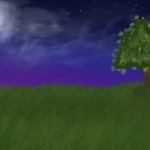“Bouncing players into the discovery of their hidden, musical talent”
Euphony is an action based puzzle game experiment that utilizes unique gameplay controls to give players the visceral experience of playing a piano while working towards a puzzle-based goal. Designed and developed on my own with weekly critiques from a group of exceptional game designers, this project contains extensive documentation (level design documents, bug reports, concept and proposal documents, and weekly delta reports) along with a buggy prototype.
Role: Sole Developer
Duration: 4 Months
Platform: Multimedia Fusion 2
Players keep their hands on home row. Each key bounces a bar upwards and plays a note on the octave scale. The main -explicit- objective is for the player to get a ball into a specific place on the map. However, when the player begins to play a chord of notes, the background and environment change as a way to subtly reward the player for their input. While the main goal of the game is not to create music, the game utilizes trickster tactics to subtly teach the player about music and help him or her find musical potential within. The interface and gameplay mechanics do not mimic those from other musical games, and this intentional decision is to focus the player on the puzzle aspects of the game.
In essence, Euphony combines the physics aspects of Peggle with an additional musical toy that rewards players for exploring the mechanics. Level design can be constructed to encourage players to hit a succession of notes to initiate positive feedback loops. Secrets and potential storylines could be unveiled to players that explore playing the piano. There are many directions that a concept like this could go in future development.
Why is this an experiment?
I have never attempted to create a gaming experience that utilizes a completely unrelated mechanic to teach people about music theory (let alone anything). The inspiration for this game comes from a youtube video I saw. The author uses several different types of phones to recreate Mozart’s Piano Sonata No. 11 3rd movement by pressing the number keys. I realize this video could be fake, but it inspired me nonetheless. Why did someone go to these lengths to learn how to create this? How can I create something that encourages a similar type of investment and curiosity, that encourages others to tap into their ability to amaze others with their skill?
Thus the concept of Euphony was born. I imagined players sitting around a single computer watching a friend play an amazing tune while managing to keep the ball from hitting the bottom. I wanted to experiment and make a prototype to see if I can encourage expression with this concept.
What I learned
The Euphony development experience was an exploration of feedback loops. I aimed to determine if I could encourage players to play with a toy while also attempting to complete a puzzle. I learned that aligning the mechanics with clear goals and encouraging positive behavior can tease that behavior out of players, but that only specific types of players will notice their own musical progression. Some players don’t bother to explore every aspect of the game, so the main gameplay loop needs to be engaging enough to keep the less curious-minded individuals having fun.
This project was an exercise in solo game production. I was learning a new game engine while simultaneously building the project. I completed weekly delta reports, redesign and iterative concept documents, and determined at the end of it all that this game would be much more successful if built in a different engine. Collision detection is buggy, causing the game to have some serious problems that were unfix-able via my knowledge of the engine. Within the time allotted, I determined to cut my losses for fixing bugs and to move forward with a plan to develop the game in Unity 3D.
Self reflection, iteration and critique became essential parts of my design and development cycles in the future. Being able to step away from my project and view it from a more objective perspective helped me determine which direction I should take to avoid making mistakes more than once. Having a group of people to playtest and critique along the way challenged me to rethink my design and determine whether or not what I had created in the end was successful. I learned to “hold onto my ideas lightly” (to quote some Trickster methodology), which has helped me become a more flexible designer and leader.









